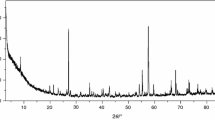Abstract
The decomposition of Pb(CH3COO)3 · 3 H2O under N2 has been studied by TG and DTA between room temperature and 450° and the products have been characterized analytically. PbO is the main solid product, besides which essentially only Pb is produced. As solid intermediates, aside from Pb(CH3COO)3 the basic acetates Pb(CH3COO)2 · PbO and Pb(CH3COO)2 · 2 PbO have been found and identified via their X-ray powder diagrams; these basic acetates have been prepared by isothermal decomposition at 240 and 305°, respectively. Among the volatile decomposition products analyzed by GC and MS and determined quantitatively, CO2 and acetone are the main products. Different routes for the formation of the other products, CH3COOH, (CH3CO)2O, acetylacetone and the intermediate ketene are shown.
Résumé
On a suivi, par TG et ATD sous N2, dans l'intervalle de températures allant de l'ambiante jusqu'à 450°, la décomposition de Pb(CH3COO)2 · 3 H2O dont on a caractérisé les produits par des méthodes analytiques. PbO est le principal produit final solide, en dehors duquel il ne se forme essentiellement que du Pb. Comme produits intermédiaires solides, on a trouvé, à part Pb(CH3COO)2, les acétates basiques Pb(CH3COO)3. PbO et Pb(CH3COO)2 · · 2 PbO qui ont été identifiés par analyse de poudres aux rayons X. Ces acétates basiques se sont formés, par décomposition isotherme, respectivement à 240 et à 305°. Parmi les produits de décomposition volatils décelés par GC et MS et dosés par des méthodes quantitatives, CO3 et l'acétone sont les composants principaux. On montre les différents modes de formation des autres produits, comme CH3COOH, (CH3CO)3O, l'acétylacétone et le cétène formé transitoirement.
Zusammenfassung
Die Zersetzung von Pb(CH3COO)3 · 3 H3O wurde im Bereich von Raumtemperatur bis 450° unter N3 mittels TG, DTA verfolgt und die Produkte wurden analytisch charakterisiert. PbO ist das hauptsächliche feste Endprodukt, neben dem im wesentlichen nur Pb entsteht. Als feste Zwischenprodukte wurden neben Pb(CH3COO)3 die basischen Acetate Pb(CH3COO)2 · PbO und Pb(CH3COO)2 · 2 PbO gefunden und durch Röntgenpulveraufnahmen identifiziert; diese basischen Acetate wurden durch isotherme Zersetzung bei 240 bzw. 305° dargestellt. Unter den durch GC und MS erfaßten und quantitativ bestimmten flüchtigen Zersetzungsprodukten sind CO2 und Aceton Hauptbestandteile. Verschiedene Bildungsweisen der übrigen Produkte, CH3COOH, (CH3CO)2O, Acetylaceton und des Zwischenproduktes Keten werden aufgezeigt.
Резюме
Методами ДТА и ТГ изуч ено термическое разложение Pb(CH3COO)2. 3Н2O в атмосфере азота от к омнатной температур ы до 450°. Продукты реакции опр еделялись аналитическими мето дами. Главным продукт ом реакции являлся PbO и, кроме того, получали свинец. В качестве про межуточных продукто в, помимо Pb(CH3COO)2, получались основные ацетаты Pb(CH3COO)2. PbO и Pb(CH3COO)2. 2PbO, которые была идентифицированы порошковой рентгено графией. Эти основные ацетаты получались приизоте рмическом разложении, соответс твенно, при 240 и 305°. Среди л етучих продуктов разложени я, которые были идентифицирова ны и количествено опр еделены с помощью газовой хром атографии и масс-спектроскопии, CO2 и ацетон являлись гл авными компонентами. Показа ны различные пути образования дру гих продуктов, CH3COOH, (CH3CO)2O, аяетилацетона и пром ежуточного кетена.
Similar content being viewed by others
Literatur
F. Wöhler, Liebigs Ann. Chem., 29 (1839) 63.
J. Petersen, Ber. Bunsenges., Z. Elektrochem., 20 (1914) 328.
H. G. Denham, J. Chem. Soc., 115 (1919) 109.
W. Krönig, Z. Angew. Chem., 37 (1924) 667.
K. Manabe undT. Kubo, Kogyo Kagaku Zasshi, 69 (1966) 1733; C.A. 68 (1968) 101392.
W. Kwestroo undC. Langereis, J. Inorg. Nucl. Chem., 27 (1965) 2533.
H. Behringer, in Ullman/Foerst, Enzyklopädie der Technischen Chemie, Urban und Schwarzenberg, Berlin, Mü nchen, 1955, 3. Aufl., Bd. 6, S. 791.
Gmelins Handbuch der Anorganischen Chemie, Verlag Chemie, Weinheim, 1969, Abschnitt Blei, Band C 2, S. 769.
R. Dubrisay undA. Saint-Maxen, Bull. Soc. Chim. France, [5] 7 (1940) 393.
R.Leibold und F.Huber, (unveröffentlicht).
Author information
Authors and Affiliations
Additional information
Dem Fonds der Chemischen Industrie danken wir für finanzielle Unterstützung.
Rights and permissions
About this article
Cite this article
Leibold, R., Huber, F. Thermische Zersetzung von Blei(II)-Acetat. Journal of Thermal Analysis 18, 493–500 (1980). https://doi.org/10.1007/BF01910230
Received:
Issue Date:
DOI: https://doi.org/10.1007/BF01910230



